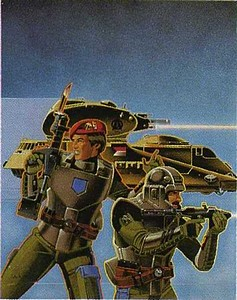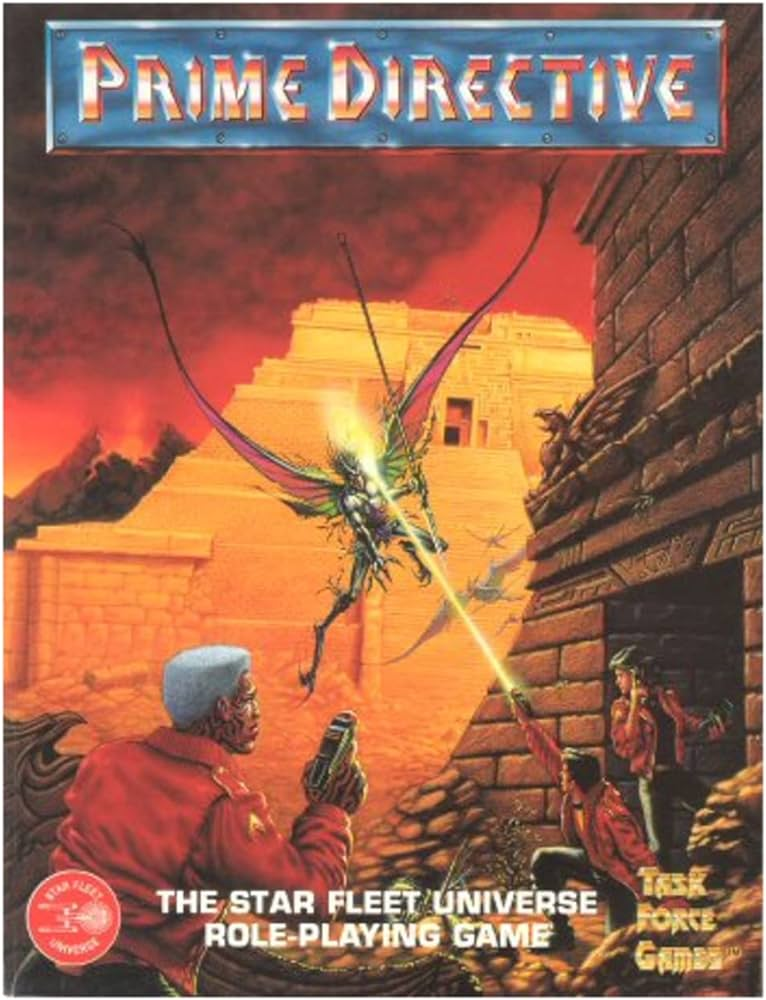I've been a Star Trek fan as long as I can remember. It's one of the earliest TV shows I can remember watching, along with Battle of the Planets and the old Fantastic Four and Hulk cartoons. When I was in Kindergarten, I had both a Spock uniform t-shirt, and the amazing (for the time) modular TMP Enterprise toy from South Bend. I raced home after school so I could catch the afternoon re-runs of Star Trek. This was, of course, the late 70s and early 80s. There was no TNG yet, no bloody A, B, C, or D. And when I started playing roleplaying games, one of the very first I got my hands on after D&D was Star Trek from FASA.
FASA's Trek was more martial than the original TV show, but not so much that it felt off. At that time, deep roleplay wasn't the default mode it can be today with some games. There are games out there with absolutely no combat allowed. FASA Trek was created in an era where conflict of some sort was assumed in an RPG as something that was going to happen. While Star Trek: The Motion Picture was a thoughtful sci-fi epic without a single phaser firing, and the only torpedoes fired weren't at other ships, Star Trek II: The Wrath of Khan was another story entirely. This is where I begin my specific love for "Nick Meyer" Star Trek. Nicholas Meyer directed Wrath of Khan, and under his influence we got the two Star Trek feature films that felt the most Naval. Wrath of Khan, and The Undiscovered Country. From the far more martial uniforms with a distinct look to differentiate officers and enlisted to details like inspections, the Excelsior crew sleeping in racks, and even corrugated metal floors, boatswain's whistles, and ship's china and blankets, Nick Meyer's Star Trek was, by a quote from Meyer himself, "Horatio Hornblower in space." The naval feel was quite intentional. And it seems to have been popular. Despite the difficulty in making the Monster Maroon uniforms from this era, they were a staple of conventions and fan clubs. Wrath of Khan was upheld as the best of the Trek films, even when Search for Spock and The Voyage Home came out, with Voyage Home returning to a less bellicose and more sci-fi-with-a-message format.
This is the Trek into which the RPG was born. Many of the sourcebooks detailed conflicts - a favorite of
mine being the Return to Axanar/The Four Years War combo. For those who don't know, The Four Years War was FASA's (and fandom's) explanation for the state of things between the Klingon Empire and the Federation in the original series. It's taken as read that there has been a "hot" war at some point in the not-too-distant past, and that it's now boiled down into an analog of the Cold War. Before Klingons were biker Viking samurai, they were basically Cold War-era Soviets. The Tactical Starship Simulator and the ship recognition guides written to support it obviously focused on combat between vessels- that was sort of the point of the game. Starfleet was, in this version of Star Trek, written to be a military organization that did exploration and science as part of their mandate. There were enlisted crew, even a mention of *gasp* Marines. The image on the right by the great David Deitrick. It was to be the cover for the Star Fleet Ground Forces Manual, which was, according to Deitrick's blog, given the kybosh by Roddenberry himself, who by that time was deep into downplaying the naval or martial influences in Star Trek.
All of this is to say, my Star Trek is much more Nick Meyer than Gene Roddenberry. And if you look at Star Trek the some way some folks cherry pick their favorite parts of various holy books, you can see that my Trek has always been a part of Trek. For instance, some folks insist there were no enlisted crew aboard the Enterprise, each member was at least an Ensign. Thing is, a bridge character in The Cage was Chief Petty Officer Garison, Crewman Green in The Man Trap was a crewman, and in Charlie X Tina Lawton is introduced as a Yeoman 3rd Class. When I got to High School, I became a cadet in the Marine Corps JROTC- so I learned a lot about the traditions and histories of the naval services. Of course I used the Marines that were listed in the Starfleet org chart in FASA Trek. The Mandela Effect ensured that I saw that entry on the org charts in the classic Franz Josef Star Fleet Technical Manual, but alas.
Since FASA Trek has a lifepath-type character generation, and the enlisted generation method in Trader Captains and Merchant Princes was... not optimal, I wrote my own process for training enlisted crew, and I gave them Navy-style ratings since I'd heard Tina Lawton called a Yeoman Third Class. So my game had Science Technicians, Warp Technicians, Torpedomen, Quartermasters, Operations Specialists, etc. Even Culinary Specialists and Starfleet Counselors. Every ship had a "Chief of the Boat" who served as senior enlisted to the Captain. My Starfleet was decidedly Naval, as presented in Wrath of Khan and the FASA books. Most of my games dealt with the Cold War between the Federation, Klingons and Romulans. FASA lost the Star Trek license shortly after producing their only two Next Generation books, and there was no new Trek RPG in print, until...
The year I graduated, Task Force Games/Amarillo Design Bureau released Prime Directive, and if Roddenberry felt FASA Trek was too martial, it might be a blessing that he passed away before the release of Prime Directive. Set in the alternate Trek universe that was created to support the game Star Fleet Battles, Prime Directive was concerned with a neat concept - Prime Teams. Why beam down your Captain, XO, and next four senior people into an unknown situation when you could have a purpose-trained "Novel Contact Team" to beam down for you. Purpose-trained, possessed of multiple skill sets, and oh, yeah, more expendable than your Captain and the next five most senior personnel. Character creation had players choosing between Naval and Marine personnel, and it was possible to be an officer or enlisted member of either service. The setting, as it was created to support the outright wargame that was Star Fleet Battles, was heavily militaristic in nature. The sample fiction in the rulebooks mentions saluting, bracing to attention for an officer, and other formalities rarely or never seen in Star Trek. Needless to say, my Prime Directive games were right at home in the kind of Trek universe in my head. Prime Directive was a shift in some elements of my games, as it was set during the TOS era due to specifics of the sub-license that allowed it to be created. I had run most of my games in what we used to call the "Movie Era" - Star Trek II up to, say, Star Trek VI. Or the current film if you rewind to my earliest days as a gamer. Also- Prime Directive had a completely different set of species in play. Rigellians and Alpha Centaurans were absent in FASA Trek, so, too, most of the Klingon servitor species. Hydrans, Lyrans, Wyn, Kzinti, all new options for NPCs and, rarely, players. This game became sort of Star Fleet Navy SEALS. Ish. And we dug it.
You might ask what I did with The Next Generation? Well, I started with the TNG First Year
Sourcebook, and then got my hands on the TNG Officer's Manual, the aforementioned two books FASA got out before their license was terminated. These books are definitely early efforts, before much of TNG's lore was established. There were some gems of concepts in here, though. The Bridge Command Specialist was pure gold. A character cross-trained in several bridge functions, so they could make a credible effort at any station. This mirrored perfectly how Geordi and Worf tended to bounce around with various duties, and why Geordi, as a Lieutenant (j.g.) is given command of the Enterprise twice in the first season when more senior officers are clearly available. A BCS is a line officer in training, and being given temporary command is part of that training.
The Officer's Manual had a lot of things that would be retconned by later TNG. Pay for Starfleet members, some apocryphal starships including the Ambassador Class that looked like neither Doug Drexler's nor the Enterprise-C's versions. Data having some sort of reactor core. The shipboard position of "Crewmaster" who was responsible for the civilians onboard. Oh, and the rank of Ensign, Junior Grade. I used most of it, because we didn't yet know any better. But oy, did some of those ship designs look janky.
By the time Last Unicorn Games released their Star Trek offerings, we were ready for a different take on Star Trek. But we always seemed to come back to FASA Trek and Prime Directive. Only with the recent move to Modiphius and their 2d20 system have my players and I found a Trek we like as much as these older iterations. And still, I just finished running FASA Trek at North Texas RPG Con. I toned down the hyper-naval feel of my game, but many elements we used to use were still there. Half the pregen characters I created were not officers. The ship was a Larson-class destroyer, assigned to Military Operations Command (as opposed to Galaxy Exploration Command.) The players said they had a lot of fun. I plan on running again next year. The takeaway is, my TNG games tended to be less martial in nature than my TOS-era and Movie-era games, and those tended to be The Navy in Space. Just as Nick Meyer intended, and Gene Roddenberry resented.



